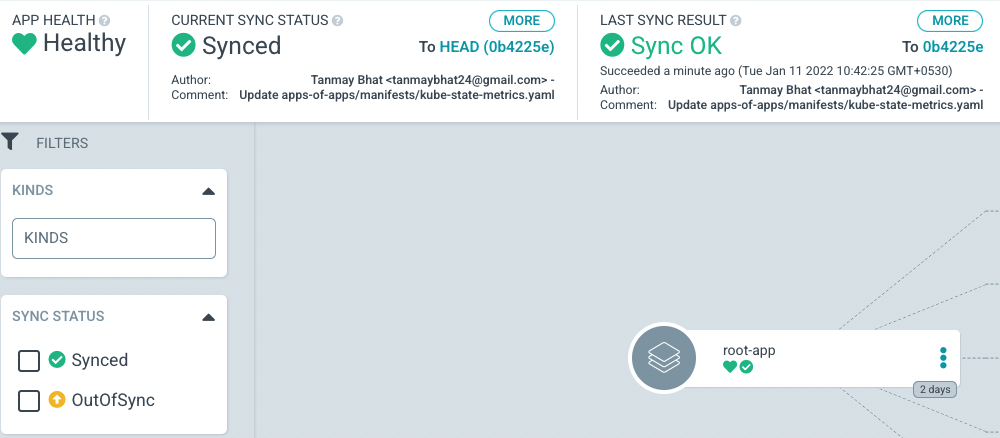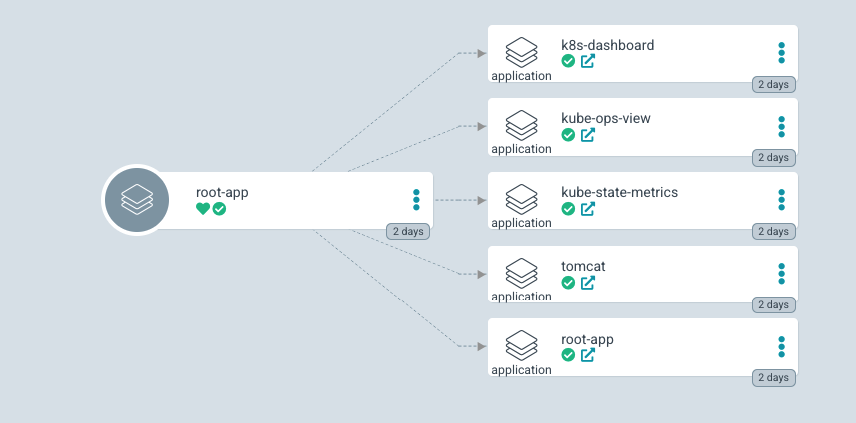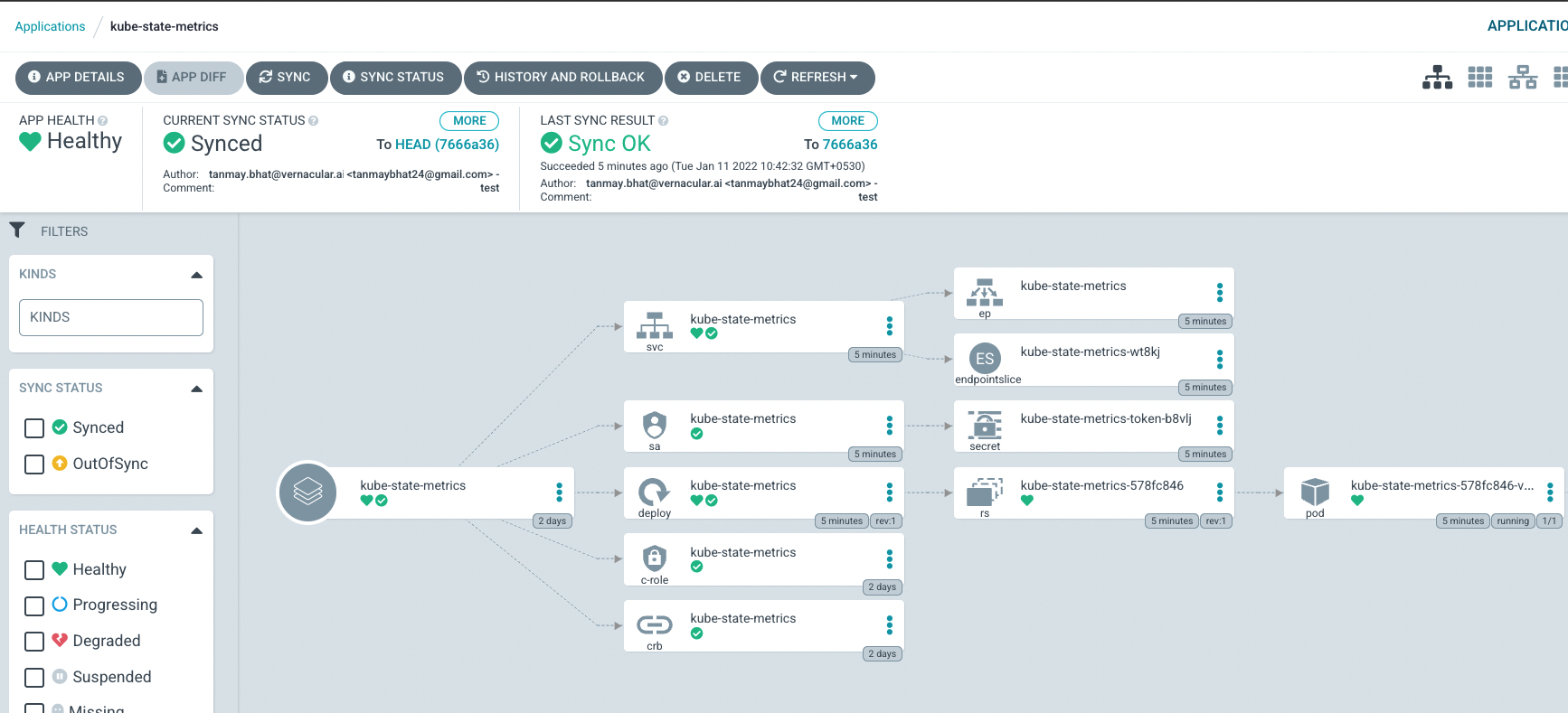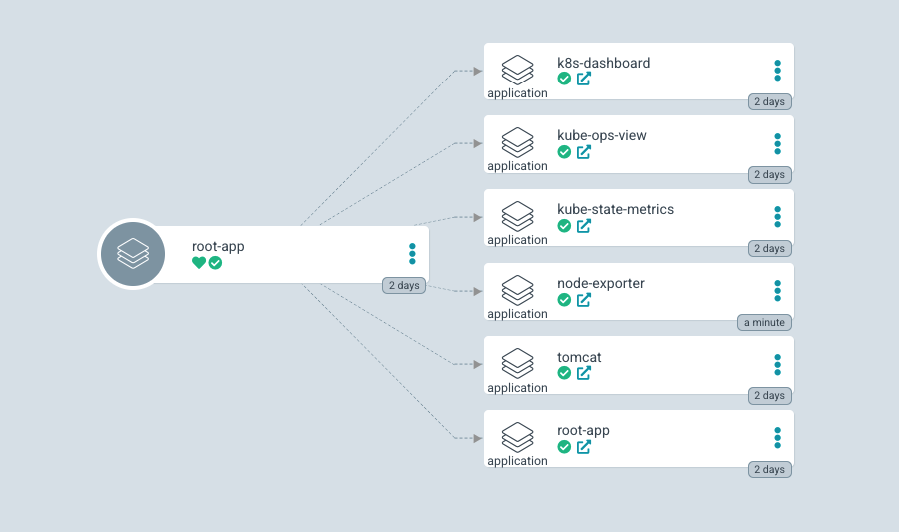What’s Apps of Apps or Cluster bootstrapping ?
The App of Apps Pattern helps us define a root Application. So, rather than point to an application manifest fort every application creation, the Root App points to a folder which contains the Application YAML definition for each child App. Each child app’s Application YAML then points to a directory containing the actual application manifests be it in manifest file, Helm or Kustomize.
ArgoCD will watch the root application and synchronize any applications that it generates.
Requirement
- You may have this question as to why is this even needed, where as you can manaully create the application via argo cli or via argo UI.
- But once the number of application you manage increases, automation needs to be done.
- For example, if you have a new app that needs to be created & deployed in your cluster via ArgoCD, apart from argo CLI and UI ( both are manual ) we really dont have any automation on creation of apps except custom scripting.
Behold : Apps of apps
Actually, it took me a while to understand what exactly it is because the official doc is not well written.
Since the concept is pretty new and as far as I know, not much of argocd users are utilising this.
Now that we know why, what lets go over to how.
Structure
- Components
- Root app : the single app you need to deploy to your cluster ( parent/root)
- child app : your actual microservice applications ( child)
- child app template : argocd Application kind template describing your application
- application manifests : the actual micro-service definitions.
High level flow
Git repo → root app → application templates → actual applications
Prerequisites
- Kubernetes cluster
- Helm v3
- ArgoCD installed
Demonstration
For the purpose of demonstration, here are the components described above :
- root app template : root.yaml
- application templates : manifests
- application definitions : charts/monitoring
Let’s take a look at root.yaml :
apiVersion: argoproj.io/v1alpha1
kind: Application
metadata:
name: root-app
namespace: argocd
finalizers:
- resources-finalizer.argocd.argoproj.io
spec:
destination:
server: https://kubernetes.default.svc
namespace: default
project: default
source:
path: ./apps-of-apps/manifests/
repoURL: https://gitlab.com/Tanmay-Bhat/argocd.git
targetRevision: HEAD
syncPolicy:
automated:
prune: true
selfHeal: true
Name: suggests the name of my root application i.e root-appnamespace: all argocd based resources should reside in argocd namespace itselfFinaliser: its the kubernetes CRD finalizer which help in protection from accidental deletion of resources.Destination: the cluster onto which the resources should deploy. If you have multiple clusters , mention the required one here.namespace: the actual namespace in which you want to deploy your apppath: path inside your Git Repo where the application manifests are.repoURL: the GIT repo address.targetRevision: if its HEAD, argocd will always sync to master branch, if you need to be a different one, update that here. For example, staging branch for Dev environment etc.prune: this enables argocd to auto remove your application and its created resources when you delete the manifest file from the Application templates directory.selfHeal: this enables argocd to auto patch the configs same as latest master branch changes even though new config updates has been done via kubectl.
Let’s look at one of the actual application template inside manifests, kube-state-metrics.yaml :
apiVersion: argoproj.io/v1alpha1
kind: Application
metadata:
name: kube-state-metrics
namespace: argocd
finalizers:
- resources-finalizer.argocd.argoproj.io
spec:
destination:
server: https://kubernetes.default.svc
namespace: kube-system
project: default
source:
path: ./Applicationset/charts/monitoring/kube-state-metrics
repoURL: https://github.com/tanmay-bhat/ArgoCD.git
targetRevision: HEAD
syncPolicy:
automated:
prune: true
selfHeal: true
name: name of my applicationnamespace: I’m deploying the app to kube-system namespace.path: the path inside GIT repo where hem charts are for the apptargetRevision: I’m synching the changes to master branch.repoURL: repo where the helm charts / manifests of app is stored.
Once, we understand the above, we can proceed to try them out :
Install the root app by running :
kubectl apply -f root.yaml -n argocdOnce installed, go to your ArgoCD UI and you should be able to see:

Now that our root app is created and healthy, give it a minute and any application template you create inside manifests folder (in my case), will be automatically synced and created for you in the specified namespace.

In the above picture, you can see root app is managing multiple apps and auto-syncs when you make changes to the helm charts (github repo in my case)
There’s a little arrow in each of the app, if you click on it, it will take you to the applciation page of it in argocd :

If you need to add a new application, the flow goes like this, add the actual helm chart/manifest file to your GIT repo → add an argocd template to your templates directory → sit back and enjoy !!
I’ve added the argocd template and bam !! app is automatically created :

Problems
- Synching apps across multiple clusters.
- Lets say you want to have node-exporter in multiple clusters, its not possible via apps-of-apps directly. For that you can create a application template and in
destinationupdate your cluster name as registred in argocd. - This problem is solved by Aplicationset from ArgoCD.
- Lets say you want to have node-exporter in multiple clusters, its not possible via apps-of-apps directly. For that you can create a application template and in
- Support for multiple values.yaml file for helm charts.
- Let’s say you want to apply node-selector to 2 clusters dev and prod each with their own customized values which is not possible at the moment.